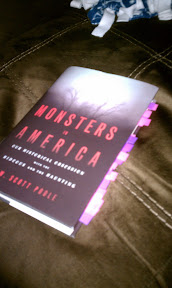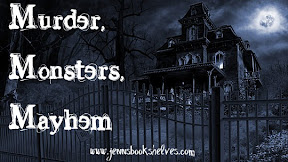- Hardcover:290 pages
- Publisher:Baylor University Press (October 15, 2011)
- ISBN-10: 1602583145
- Source: Publisher
Monsters have been a staple of American culture for decades, from the Salem witch trials to alien invasions and the walking dead. They didn’t just appear randomly; in Monsters in America Poole provides both historical and cultural studies that detail how and why these monsters became a part of our national identity. The book argues
“the origins of all of Amercia’s monster obsessions lie in something more substantial than media-driven cultural ephemera. American monsters are born out of American history. They emerge out of the central anxieties and obsessions that have been a part of the United States from colonial times to the present and from the structures and processes where those obsessions found historical expression.”
Christopher Columbus, great discoverer of the “New World” wrote in his diary of natives he encountered in the Caribbean, referring to them as ” one-eyed men and other men with the dog heads’ who decapitated their victims and drank their blood.” Finding monsters soon became an obsession for Columbus.
Puritans hunted monsters long before the Salem witch trials. The first settler accused of witchcraft was actually Margaret Jones in 1648. The obsession with witchcraft and hunts continued long after the Salem trials, African-American slaves were often accused of “conguration” or “sorcery”, the use of black magic against their white masters a common charge.
The slave industry has long represented a sense of overwhelming doom & darkness, starting from the slave ship itself. Slaves often believed their masters to be cannibals, the slaves captured to serve as a food source for the slave masters. Many assumed the fires on decks of slave ships, intended to keep disease away, were instead cooking fires. Louisiana slaves saw their masters drinking red wine & assumed it was the blood of their African victims.
A cultural obsession with the dead became prevalent during the Civil War. Wounded bodies filled the streets, disabled veterans roamed the streets with missing limbs. These were many of the first visual instances of any sort of trauma to the human body. War photographer Matthew Brady documented the war with photography, showing citizens a side of the war they had never seen. The bodies were actually posed so they would produce the most emotional impact. These photographs were displayed in an exhibition before being purchased by Congress, then used as photographic evidence of the conflict.
When Jack the Ripper ran rampant in England, the interest in these murders became just as popular in the United States. Several news publications suggested that many unsolved murders were actually victims of Jack the Ripper, despite the fact he was across the ocean in an entirely different continent. The American obsession with monsters continued.
The current obsession with watching grisly scenes of torture and death as a source of entertainment did not start with the Saw franchise. Public viewings of executions, including hangings, beheadings & lynchings, were not uncommon in the 1800s. Oftentimes, these executions were reenacted for public entertainment.
Human beings as monsters, specifically those individuals of a race other than Caucasian, has run prevalent in American history. African Americans have long been portrayed as monsters, specifically the men. These accusations not only appeared in sermons or public speeches but also in medical journals. African American males were reported to have a monstrous sexual desire that could not be satisfied by women of their own race, all based on the size of their genitalia.
The claims of hypersexuality in African Americans was showcased in the 1933 film, King Kong. White women have long been victims of this hypersexuality. African males were often referred to as “black beasts” and “ape-like”. The monster in this particular film seeks out a blond, beautiful, Caucasian woman. It was this desire for a white woman that caused the ape’s demise.
Actual monsters have also run rampant in American history. The “monsters” that in the 1930s performed medical tests on poor sharecroppers in Alabama, the infamous Tuskegee experiments, is evidence of this. In the 1950s and 60s Dr. Albert Kligman performed experiements on prisoners at Philadelphia’s Holmesburg prison. He used prisoners, many African American, to test skin care products. He would remove large chunks of skin from prisoners for testing. The prisoners were left with a checkerboard pattern of healing wounds on their backs.
As movies, books, comics became even more accessible, authors, graphic artists film makers used these tools to exemplify society’s fears. Following is a brief timeline of substantial events in US history, followed by popular media of that time:
- 1950s Fear of the atomic bomb created an increased obsession in human abnormalities as a result of nuclear attack. Popular films included: Godzilla (monster created by atomic testing)
- 1960s Women were often given a tranquilizer called Thalidomide as a cure for morning sickness. It was soon discovered to cause traumatic and extreme birth defects. Additional The Love Canal tragedy caused numerous instances of cancer and other diseases. Editor Stan Lee created The Fantastic Four, human mutant heroes. Many more icons of popular culture, all created from some kind of radioactivity, were formed, including Spider-Man and the X-men.
In the 1970s-1990s, the term serial killer became more prevalent. The names Gein, Bundy, and Dahmer became familiar names. Following the horrible crimes at the hands of these monsters were films describing and featuring similar individuals, including Silence of the Lambs, The Texas Chainsaw Massacre, and Psycho. Citizens of this country had read so many vivid and explicit stories of the real-life monsters’ crime that violence and gore in movies became more prevalent.
I’d be remiss not to mention The Exorcist, a film that caused an extreme outcry from the Catholic Church. This film without a doubt made a statement about the place of religion in our society. Rosemary’s Baby was yet another film that showcased the growing religious crisis in this country.
I could quite literally go on for pages upon pages on this subject. With my background in psychology, sociology, and criminal justice, and my love of the horror genre, I couldn’t help but immerse myself in reading Monsters in America. I barely touched the surface on the wealth of information provided in this book. To give you a visual, here is what my copy of the book looks like after reading it:
Those pink things you see sticking out of the book are post-it flags, used to mark passages I found interesting & compelling.
Monsters in America is a book full of historical data and research, so not exactly light reading, but incredibly rewarding and fulfilling reading. It is not a book meant to be read straight-through, but instead read in bits & pieces. Unless you are like me, who became so obsessed with this book that I took it everywhere, frequently reading passages allowed to my husband and coworkers. It’s a given that Poole did a tremendous amount of research on this topic, thereby producing a work like none other. I haven’t come across a book that explores our history as it relates to horror in such tremendous and substantial detail.
I don’t read a great deal of non-fiction so the following statement is even more powerful: Monsters in America has without a doubt earned a spot on my favorite books of 2011. Highly recommended.
Check back later today with a special guest post from the author, Scott Poole!









Pingback: Mx3 Guest Post: Scott Poole, Author of Monsters in America | Jenn's Bookshelves
Pingback: It’s Monday! What Are You Reading This Week? | Jenn's Bookshelves
Pingback: Review: The Exorcist: 40th Anniversary Edition by William Peter Blatty | Jenn's Bookshelves